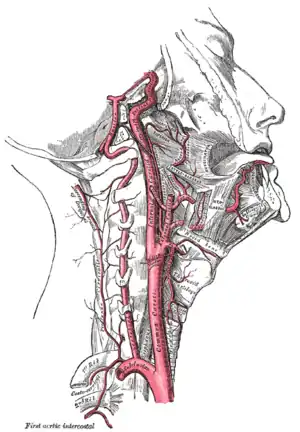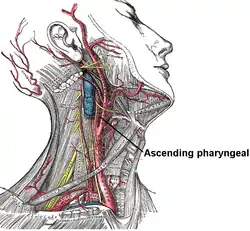Ascending pharyngeal artery
The ascending pharyngeal artery is an artery of the neck that supplies the pharynx.
| Ascending pharyngeal artery | |
|---|---|
 The internal carotid and vertebral arteries. Right side. | |
 Superficial dissection of the right side of the neck, showing the carotid and subclavian arteries. | |
| Details | |
| Precursor | aortic arch 2 |
| Source | External carotid artery |
| Supplies | Pharynx |
| Identifiers | |
| Latin | Arteria pharyngea ascendens |
| TA98 | A12.2.05.010 |
| TA2 | 4378 |
| FMA | 49497 |
| Anatomical terminology | |
Its named branches are the inferior tympanic artery, pharyngeal artery, and posterior meningeal artery. inferior tympanic artery, and the meningeal branches (including the posterior meningeal artery).[1]
Anatomy
The ascending pharyngeal artery is a long and slender vessel.[1]
It is deeply seated in the neck, beneath the other branches of the external carotid and under the stylopharyngeus muscle. It lies just superior to the bifurcation of the common carotid arteries.
Origin
It is the first (and smallest) branch of (the proximal part of) the external carotid artery. It arises from the medial (deep) surface of the vessel.[1]
Course and relations
The artery ascends vertically in between the internal carotid artery and the pharynx to reach the base of the skull.[1]
The artery is crossed by the styloglossus muscle and stylopharyngeus muscle. The longus capitis muscle is situated posterior to the artery.[1]
Branches
The artery most typically bifurcates into embryologically distinct pharyngeal and neuromeningeal trunks.
The pharyngeal trunk usually consists of several branches which supply the middle and inferior pharyngeal constrictor muscles and the stylopharyngeus, ramifying in their substance and in the mucous membranes lining them. These branches are in hemodynamic equilibrium with contributors from the internal maxillary artery. The neuromeningeal trunk classically consists of jugular and hypoglossal divisions, which enter the jugular and hypoglossal foramina to supply regional meningeal and neural structures, being in equilibrium with branches of the vertebral, occipital, posterior meningeal, middle meningeal, and internal carotid arteries (via its caroticotympanic branch, meningohypophyseal, and inferolateral trunks). Also present is the inferior tympanic branch, which ascends towards the middle ear cavity; it is involved in internal carotid artery reconstitution via the "aberrant carotid artery" variant. The muscular branch of the ascending pharyngeal artery is in equilibrium with the odontoid arcade from the vertebral artery.
It typically has two branches: the inferior tympanic artery, and the posterior meningeal artery.
Anastomoses
The artery forms anastomoses with the palatin branch of facial artery, and ascending cervical arch of inferior thyroid artery.[1]
Development
The artery develops from the proximal part of the embryonic second aortic arch.
References
- Standring, Susan (2020). Gray's Anatomy: The Anatomical Basis of Clinical Practice (42th ed.). New York. p. 585. ISBN 978-0-7020-7707-4. OCLC 1201341621.
{{cite book}}: CS1 maint: location missing publisher (link)
![]() This article incorporates text in the public domain from page 557 of the 20th edition of Gray's Anatomy (1918)
This article incorporates text in the public domain from page 557 of the 20th edition of Gray's Anatomy (1918)